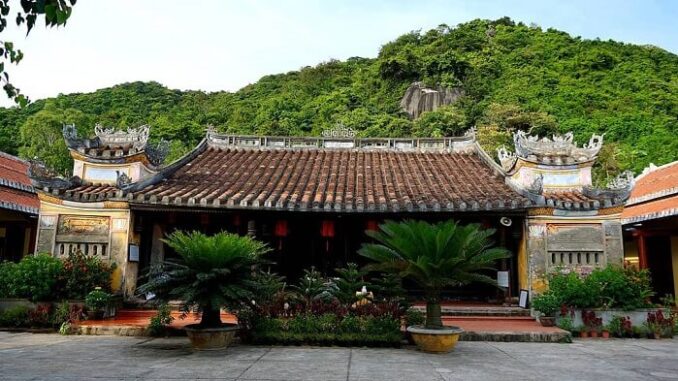
Cu Lao Cham is one of the famous tourist destinations of Quang Nam, but when you arrive on this island, you must definitely visit Hai Tang Pagoda, an ancient temple that is very sacred, a religious place spirituality of the people on the island come to worship, worship Buddha to pray for peace and prosperity.
See also: Hoi An Tourism
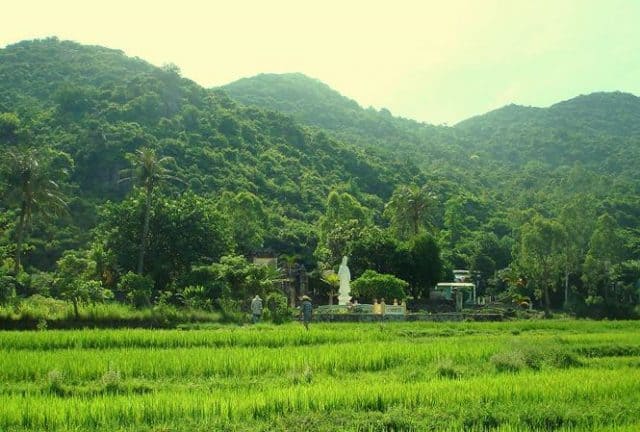
The temple is located between the vast green fields and mountains of the same forest (Photo ST)
To reach Hai Tang Pagoda in Cu Lao Cham , you have to take a train from Cua Dai pier, located about 15km from Cua Dai beach, so if you take a train, it will take about 1 and a half hours to go by canoe, you just need to go. About half an hour to arrive. The boat will dock at Bai Lang, you just need to follow a small but slightly zigzag road to reach the village of Com, about 300 miles from the pier, the pagoda appears with a serene look in the middle of the beautiful island.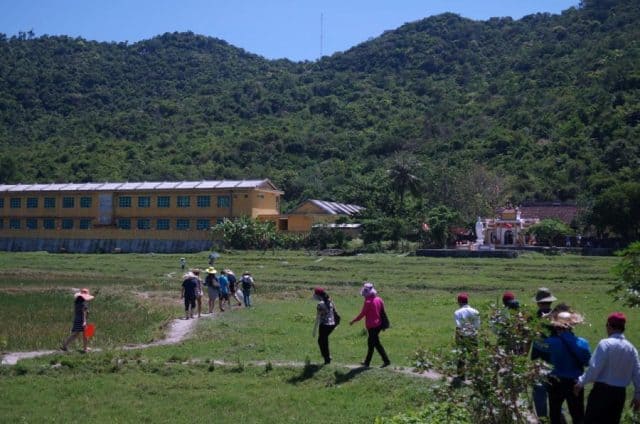
From Bai Lang on Hon Lao Island, following small, winding roads about 300 meters to Com village, where the ancient pagoda of Hai Tang (Photo ST)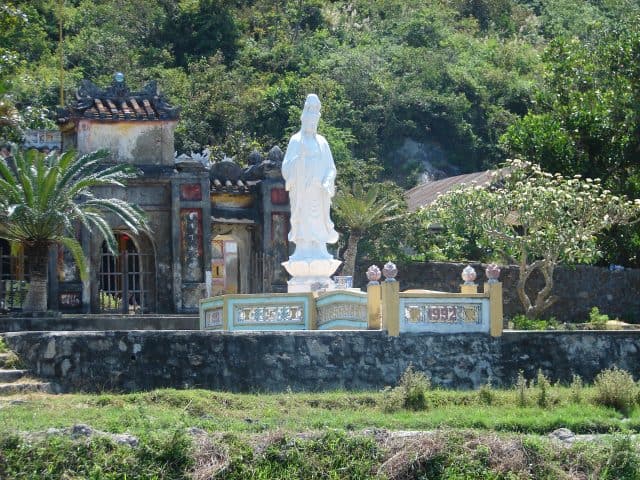
Right from the far side of the pagoda, visitors can see a statue of Buddha Lady Quan Am worshiped right in front of the temple gate (Photo ST)
The temple was built in 1758 in the 19th Canh Hung year, located in the north of the island of Cu Lao, but then in 1848 had to relocate the temple to the location 200m away due to the severe devastation of the flood that year. masonry. This relocation location is considered to be a suitable place for feng shui, ideal for the Buddha’s residence as well as more convenient for people in the area to light incense, worship, worship, pray to Buddha.
The history of Hai Tang pagoda is also told by legend that in the 17th century, there was a boat carrying wooden pillars made from the North to the South for consumption, when going to Cu Lao Cham, it was dark, so they stopped. Island to rest. When it was morning, the group continued their journey, the sea suddenly became big and big. If they continued going, it would be very dangerous so they had to stay on the island.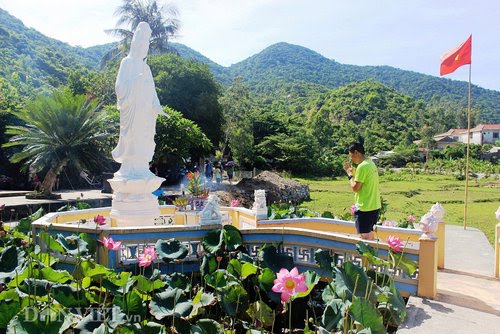
Statue of Bodhisattva Guan Yin 3 m high standing on a lotus in the middle of the lotus lake (Photo ST)
Seeing the sea raging forever, someone in the delegation climbed to a temple to pray and pray for the sea to continue the trip, there are local gods who said that if you want the sea to be calm, you need to Use these wooden pillars to build the temple right here, then hope to leave the island. The pagoda was erected from there and took the name Hai Tibet, the sea means the sea, the organ is the classic Tripitaka, the name with the meaning of the pagoda is the gathering place of immense and rich Tripitaka like the sea.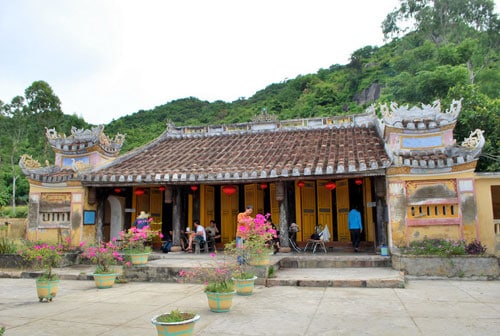
In front of the porch is a door system with 3 sets of large doors, each with 4 doors separating the space between the inside of the temple and the courtyard (Photo ST)
Inside the main hall (Photo ST)
If you visit the tour style, you will definitely hear about the legend above as well as listen to the explanation of Hai Tang Pagodain the most detailed and complete way. Right outside is the gate of tam quan, tinged with moss over time, built in the old architecture with 4 pillars 5m high, the gate length is 6m, at the top of the pillar there is a lotus-shaped block with the width. 1.5m. If it was a three-door gate, there would be three entrances with two small gates on either side and the entrance at the middle gate in a domed style, with roof tiles covered by yin and yang tiles above, the roof was embossed with lines. winding is very smooth and soft.
Opposite to the three-door gate, you will see a 3-meter-high statue of Bodhisattva Guan Yin in front of you standing on a lotus in the middle of the lotus pond. The statue faces the sea as if it means to protect the residents here a peaceful, warm and happy life. If you look from the sea, you will see a white statue clearly standing out among mountains, fields, vast blue sky and clouds,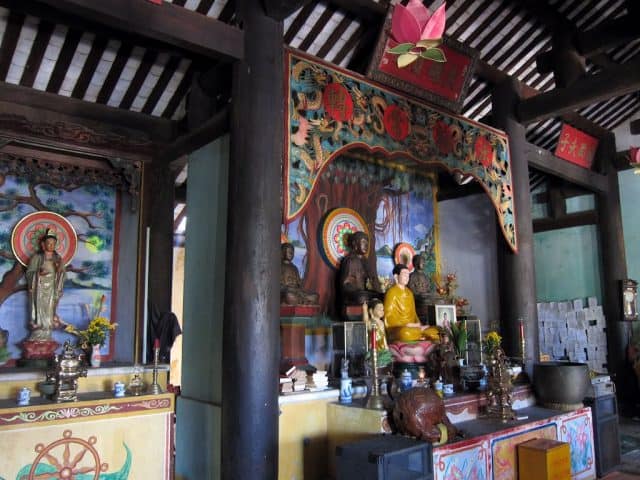
Hai Tang Temple is a place where people often go to pray for health and fortune (Photo ST)
Ancient architectural carvings (Photo ST)
Going inside, you will see the main house is built with a truss system “stack of fake chest” consisting of 3 rooms. Inside the main hall, worshiped in the middle space is 3 statues of Tam The Buddha, the statue of Tam Thanh Quan Cong, Chau Xuong and Luu Binh worshiped on the right side (looking from the pagoda) and the left space is worshiping Dia Tibet Vuong Bodhisattva . On the two sides of the main hall, there are also worshipers of Dharma, Dragon God and stele engraved with Chinese characters. If you go around to the back of the temple, you can see the altar of Patriarch Dat Ma with a letter-book in his hand, half-old. The diaphragm and red couplets are designed inside to bring an extra majesty to the temple. All the statues inside the main hall are made of wooden materials, not cast in bronze or gold as today, painted with gilded vermilion, dating back to the time of building the pagoda up to now, it has been 260 years. .Hai Tang pagoda Cu Lao Cham has remained forever with the times, witnessing all the changes of earth and heaven. Notably, the large common persimmon fruit with the word “Dragon of the tide”, has a carving of the dragon on the bell, but the dragon’s feet only have 4 fingers, scales, curled shape, and the dragon’s head is flexible and bearded. Long, clearly depicted on the bell can show the style of the early Le dynasty, meaning that the bell existed before the temple was built.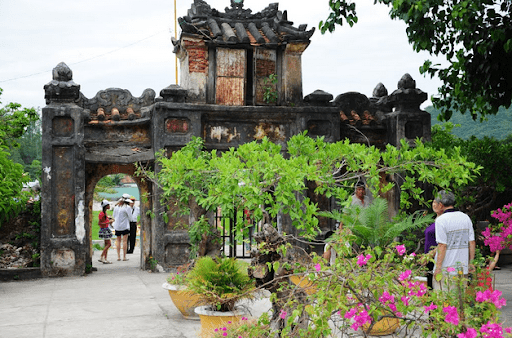
In the courtyard, ornamental plants create an airy and fresh space (Photo ST)
This place is one of the few landmarks of Da Nang that still preserves many ancient cultural features left behind (Photo ST)
When you visit the temple, you will not see a monk but only a couple who are also of the same age to look after the temple. The temple preserves almost completely the architecture, artistic structure, despite more than 2 centuries, is the main spiritual spiritual gathering of the people on the island, this place has become a symbol of Cu Lao island, goes into people’s subconscious mind a place to pray for peace, for good rain and wind to do business.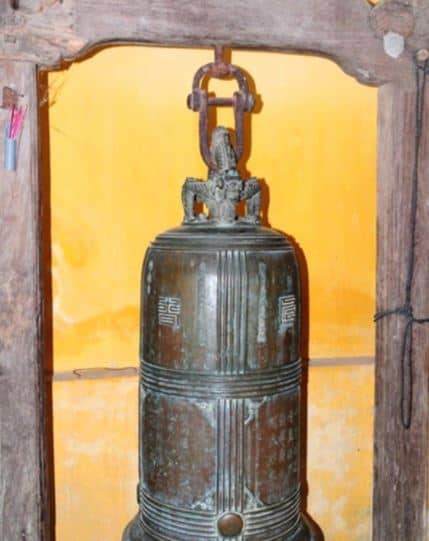
The pagoda also preserves a large common persimmon fruit, with a sculpture of “Song Dragon of the tide” on the bell
If you have the opportunity to visit Cu Lao Cham, you should remember to visit Hai Tang pagoda to learn more about history, to worship the Buddha, and to admire the beautiful pagoda in the wild mountain and forest nature to have some peace of mind. Please!
